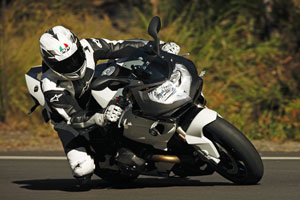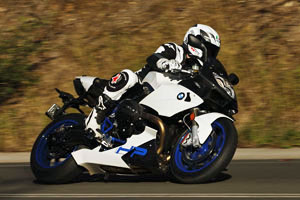MotoOnline.com.au takes the 2009 model BMW HP2 Sport for its first full test on Australian roads.
BMW HP2 SPORT SPECIFICATIONS
ENGINE
Engine type: Air/oil-cooled 2-cylinder 4-stroke flat twin, two camshafts, 4 valves per cylinder, central balancer shaft
Bore x stroke: 101 x 73mm
Displacement: 1170 cc
Compression ratio: 12.5:1
Transmission: Six speed
Power (claimed): Over 133hp
Torque (claimed): 85ft-lbs
CHASSIS
Frame type: Tubular steel space frame, front and rear made of self-supporting carbon
Front suspension: Telelever, spring pre-load continuously variable, compression damping, rebound damping and vehicle height adjustable
Rear suspension: EVO Paralever, Öhlins central spring strut, spring preload continuously adjustable, rebound and compression damping adjustable, vehicle height adjustable
Wheelbase: 1485mm
Wheels (front/rear): Milled cast aluminium 3.50 x 17″ / 6 x 17”
Tyres (front/rear): 120/70 ZR 17 / 190/55 ZR 17
Brakes (front/rear): Dual 320mm floating discs, Brembo monobloc 4-piston caliper / Single disc, diameter 265 mm, double-piston floating caliper
DIMENSIONS
Weight (dry, claimed): 178 kg
Seat height: 830mm
Fuel capacity: 16 litres
PURCHASE DETAILS
Price: $34,750 + orc
Colour options: Alpine White
Test bike from: BMW Motorrad – www.motorcycles.bmw.com.au
The throttle’s twisted, engine’s screaming, and my head’s down beneath the tiny tinted bubble also known as the windscreen.
As each gear shift comes calling my right wrist remains at full tilt, simply tugging up on the gear lever with my left foot to bounce to the next gear without a worry in the world.
You see, the quick-shifter on BMW’s HP2 Sport is possibly my favourite thing about the entire motorcycle. Not because of its simplicity in up-shifting through the gearbox, or because of its functionality, but simply because it’s new and it’s desperately fun.
With each click up to the next gear comes a slight popping noise from the engine that signals it’s automatically been cut out momentarily in order to quickly allow the up-shift, reminding me very much of race bikes that I’ve ridden over the years.
It’s features like the power-shifter that make the BMW an absolute blast to ride, giving us something unique to explore and making the testing experience enjoyable due to this bike being the first production streetbike in the world to come standard fitted with a quick-shift system.
Add in the ABS braking system and you’ll have even more to play with, not to mention the Telelever front-end, chainless drive, and MotoGP-derived 2D instrument panel.
There are many things about the HP2 Sport that set it apart from many bikes I’ve tested in my journalism career, but if there’s one thing that is becoming very consistent no matter what the ride is, it’s that performance is leading edge – especially on the R 1200 S-based Sport.
Stemming from the R 1200 S and being very similar to the Sport Boxer world Endurance race bike that BMW Motorrad contested rounds of the 2007 and 2008 Endurance World Championship with, the HP2 Sport was actually launched in late 2007.
It’s been only available in limited quantities since then, with around 30 bikes delivered in the 18 month timeframe since it was announced, and we managed to get our hands on this one for the first Australian road test of the bike just weeks after BMW Motorrad Australia announced that it had secured additional volume of the exclusive model – which some enthusiasts are even considering as a collector’s item.
At first glance the HP2 is a standout. Ride it on the Putty, to the shops, or through the city to work and you’ll be sure to catch the eye of more than a few curious onlookers.
The flat-twin engine configuration sets minds racing as it bulges out the side of what is otherwise a fully-faired bike, with the carbon-fibre glistening from front to rear in shades of white and blue that certifies it as a true Beemer.
Personally I like the look of the rear of the bike better than the front in the flesh, although you can’t argue with the intended styling of the bike that signifies you’re on something special.
Once aboard and cruising through some tight sections of New South Wales roads I instantly notice the bike’s tendencies to fall into each turn, with minimal rider input causing it to steer quickly and precisely – a great surprise considering the bulky size of the bike overall.
But it isn’t consistently like that for my entire test as sometimes it tends to steer exactly on target, while other times I have to give it that touch more input to point it in the right direction.
I’d say that’s because of the lengthways crank rotation in the engine, as the slower the turns seem to be, the more that each blip of the throttle on downshift tends to slightly pitch the bike from left to right.
The pitch is also noticeable at a standstill, and for those who have ridden with the Boxer engine before you’d be aware of this feeling. But the good thing is that apart from that, you’d hardly even realise you had two massive cylinder heads hanging out the side.
Out in the more open areas the bike’s steering prowess is even better as the revs are slightly lower with the engine chugging along, allowing me to take full advantage of the bike’s stability.
I feel as though each corner turned is a joy, not only because the bike handles them so easily, but because I find myself searching within my limits as to how far I can actually continue to push.
Bumps aren’t a problem as the front and rear Öhlins suspension units soak them up, not bouncing off them, but rather feeling slightly springy on the rebound as the suspension does its job nicely – not transferring any sudden shocks to the body or wrists.
I must admit though that on constant radius corners where I’m cranked over for a long time I begin to nervously await touchdown of the cylinder heads. Luckily it never happens for me, but in case it does there are replaceable sliders on the bottom of each side.
On corner entrance, mid-corner, and the exit I find the HP2 Sport confidence inspiring, although it does take a considerable amount of time to adjust to the limited weight transfer under braking and that’s because of the Telelever front-end set up.
Whether you’re braking to a standstill from high speed or easing to a stop at traffic lights, the dive in the front isn’t big at all, although it is designed to dip a little bit. It gives the feeling that you’re slowing down and then levels out for precise braking.
What this does is allows you to squeeze the front brake lever hard without fear that you’ll lose grip at the back if the rear rises off the ground, and it typically works well once you’re accustomed to the feel and have confidence in the system.
The adjustable compression knob situated on the fuel tank is featured on the HP2 but not on the R 1200 S, and it does offer ample adjustability that can be felt while riding, also proving easy to adjust on the fly.
As for the rear suspension, its tractability off the turns is good for the amount you can push on the public roads, but something tells me that it has a whole lot more up its sleeve if you were to take it on track.
It doesn’t squat at all on the exit of the turns, allowing you to accelerate and hold your line well without running wide at all if you got the first section of the corner correct.
The Metzeler Racetec K3 tyres compliment the handling at both the front and the rear, offering sticky grip with a good heating period despite the cool winter weather that we’re currently experiencing.
I wouldn’t be too fond of the tyres in the rain though, because as with most sports tyres these days they have next to no tread in them at all that would effectively rinse water away.
Also assisting the handling is the smooth characteristics of the flat twin-cylinder engine, which has good throttle response, and actually sounds somewhere between a V4 and a twin when at low revs.
The close ratio gearbox allows you to surge through the gears like a racer, but I do find it best to actually shift around 6500rpm, which is far before the claimed peak power point of almost 9000rpm.
Sure, you can rev it harder than I do, but for some reason I just feel like it’s better to somewhat short-shift the engine in order to continue accelerating, which sees me shift into sixth gear quickly at all times.
What I do find is that the power-shifter actually works smoother when the revs are higher and you’re rolling along, because at low speed it tends to jerk into the next gear unless you use the clutch to assist the shift.
Speaking of the brakes earlier, the Brembo front brakes offer good feel from the lever and the stopping power is superb. My only complaint is that they feel rather wooden on initial application.
ABS is certainly a great safety bonus, and I find that the rear brake is much more affective with the anti-lock system turned on, allowing me to use it with a fair amount of pressure applied and having no fear of locking it up.
The controls on the Sport are all exceptionally placed apart from the annoying indicator placement on each handlebar rather than the more common switch on the left handlebar.
Adjustability is key in all of this as the handlebars, levers, and footrests are all moveable, meaning that you shouldn’t find it too difficult to find a seating position that suits you.
When seated on the bike and in the riding position it doesn’t feel as large as it looks, and the reach to the ’bars is comfortable enough for long distance riding, yet sporty enough for circuit use.
I find it comfortable as it came from BMW, and my shorter stature means that I’m able to gather pretty good wind protection for my shoulders behind the fairing and windscreen, while the screen also does a nice job of pivoting the air above my helmet.
The mirrors are surprisingly useful when moving your body position slightly to see what’s behind you, but they do take a little bit of minor tweaking to get spot on for the most complete rear vision.
Browse down at the instrument panel and you’ll be excited with the 2D dash because it looks great, works brilliant, and is exceptionally easy to use via the controls on the left handlebar.
The digital display is easy to read, with its large speedometer, gear indicator, tachometer bar, clock, and total mileage all taking prominence on the road page of the dash.
The gear indicator comes in very handy with the deceptive engine, often forcing me to glance down to double check what gear I’m in.
Of course there are the usual array of warning lights, indicator lights and trip metres, but it’s all very straight forward to use. The track page of the display features lap times and the sort, offering a well rounded package that will give you all the info you could hope for while in the hot seat.
After a great week with the HP2 Sport I feel as though I’ve been introduced to an entirely new world of motorcycling, with its racey feel and top level build quality winning me over with each wheel turned. Now I just can’t wait to get my hands on the S 1000 RR superbike so I can get back to perfecting my quick-shifts through the gearbox on the streets.
BMW certainly is pushing the envelope of evolution is the sportsbike market, and you can bet that with even more experience in the sportsbike market the German manufacturer will be one to watch for in any give sportsbike test.
TECHNICAL INFORMATION:
CYLINDER HEADS
While the BMW HP2 Sport may be based off of the R 1200 S, the cylinder heads on the Sport are much different in the search for more power out of the Boxer engine.
The big difference in the four-valve cylinder heads is that the Sport has a double overhead cam design, replacing the R 1200 S’s high-cam and rocker-arm format, and the cylinders are actually 10mm slimmer than the single cam versions on the standard model.
An altered combustion chamber is more compact and much flatter, with the inlet and exhaust valves now disposed radially to each other and operated by conically ground camshafts.
The dual ignition that is on the R 1200 S isn’t needed any longer due to the improvements in breathing, combustion and mixture swirl of the Sport, leaving it with a single spark plug per cylinder.
What all of this does when combined is contribute to a higher revving and greater performing engine, with a higher ground clearance than the R 1200 S that will allow riders to take full advantage of the Sport’s handling capabilities.
Externally the engine changes are obvious via new carbon cylinder head covers that are also fitted with slip pads made from PA6 hard plastic – easy to replace for those who scrape them on full lean.
ENGINE
With a total capacity of 1170cc and a claimed 96kW of power and 115NM of torque, the Sport model is a high performance bike that is capable of track and high performance road riding.
The air/oil cooled, DOHC, eight-valve, Boxer twin-cylinder features a bore and stroke of 101 x 73mm, with a compression ratio of 12.5:1.
As noted in the cylinder heads breakout, the HP2 Sport features a double overhead cam design and other minimal changes in order to raise its performance, and the Sport engine also features forged Mahle pistons fitted to up-rated steel conrods.
Just like the R 1200 S motor, the Sport model has twin gear-driven counter-balancers positioned on a single shaft at the rear of the cylinder block.
The HP2 Sport has a close-ratio six-speed gearbox that’s fitted with helical gears and an F1-derived gear selection system that uses sleeves and rollers rather than conventional forks.
A race-style quick shifter is also fitted to the engine as standard equipment, although engaging the clutch for a more traditional style of shifting automatically disables the quick-shifter for those who prefer not to use it.
The Sport has the typical BMW single-plate diaphragm-type clutch.
For the first time on a boxer road bike the stainless steel exhaust system runs beneath the sump and then goes up to a single under-seat muffler at the rear, and is very much similar to the Akrapovic system used on the Sport Boxer world Endurance racer.
The major difference between the pair is that the street version is Euro 3 compliant and has the emissions catalyst, so while it is 7kW down on power from the race bike, the Sport is over 5kW more powerful than the R 1200 S.
CHASSIS
The HP2 Sport chassis is essentially similar to the layout of the R 1200 S, using the flat-twin engine as a fully stressed component, but it does have central and front tubular steel frame sections matched to a self-supporting carbon-fibre subframe at the rear.
The carbon-fibre subframe weighs just 2.2kg and saves 2kg over the aluminium version that’s used on the R 1200 S.
A Telelever front end features a fully adjustable Öhlins race shock that also has adjustable compression damping via a remote knob at the front of the fuel tank – a feature that isn’t on the R 1200 S. Marzocchi-made telescopic struts are used and are featured in billet triple clamps, milled from solid aluminium billet.
A fully adjustable Öhlins shock is also used for the rear suspension.
The Brembo brakes at the front feature twin 320mm discs that are clamped by a pair of four-piston radial mounted calipers, while the rear brakes are made up of a 265mm disc and one-piston caliper.
Braided steel brake lines are incorporated, as is a switchable ABS system that specific for the HP2 Sport.
The Sport runs on weight and stability optimised surface-milled PVM forged wheels of 3.5 x 17″ at the front and 6.0 x 17″ at the rear, fitted with Metzeler Racetec K3 tyres (120/70 ZR17 front and 190/55 ZR17 rear).
Weighing in at 178kg dry and 199kg ready to ride according to BMW’s press kit, the HP2 Sport is actually three kilograms lighter than its world Endurance racer brother, the Sport Boxer.
STYLING
Featuring very funky and elegant styling, the circuit-focussed BMW HP2 Sport has carbon-fibre splashed all over it along with beautiful aluminium components throughout the entire motorcycle.
The MotoGP-derived 2D dash is identical to what’s used on the Sport Boxer endurance racer, featuring different pages for both road and track use, being an easy to navigate and clear functioning unit with a digital layout and separate warning lights. It also features a bar across the top to indicate the shift points.
Compared to the R 1200 S, the rider sits closer to the handlebars in a more upright position, with the forged aluminium footpegs, the standard handlebars, and the radial Magura brake and clutch levers all adjustable to suit a wide range of rider sizes.
Composite carbon fibre is used for the front fairing and belly pan, and the bike also has a simplified rear structure that has an easily detachable licence plate and tail light – making the HP2 Sport race-ready in seconds.
The front of the bike has large lightweight, high-luminosity halogen twin headlamps with free-formed surface reflectors surrounded by the carbon fairing and trade-mark kidney grilles which feed air to the oil coolers.
Indicators are minimalist on the bike, hardly noticeable unless within a close proximity of the motorcycle.
It’s different and unique, but ultimately very stylish – setting the HP2 Sport apart from any other sportsbike on the market.
RACING HERITAGE
All eyes may be on BMW Motorrad’s factory world Superbike team with star riders Troy Corser and Ruben Xaus this year, but it was in 2007 when the German manufacturer returned to world championship racing for the first time as a factory effort in 50 years.
Back then the R 1200 S-based Rennboxer made its debut in the prestigious Le Mans 24-Hour, finishing a very respectable 16th in a field of Japanese four-cylinders, before going on to finish a brilliant seventh overall at the final Endurance World Championship round at the Qatar 8-Hour.
The team then went on to compete again last season, with their highlight being a 1-2 finish in the Open class of the EWC at the Oschersleben 8-Hour for 12th overall, before wrapping up their two year campaign with another Open class victory at the Bol d’Or 24-Hour before moving on to focus on WSBK in 2009.
Perhaps BMW’s greatest achievement to date with the HP2 Sport racer was fifth and sixth in last year’s Daytona 200 AMA Formula Xtreme race against a horde of factory-backed four-cylinders.
All of those race results have added great credibility to the HP2 Sport’s race track credentials, taking on the best in the world and doing an admirable job along the way – in both speed and durability.The Forsaken ipod












